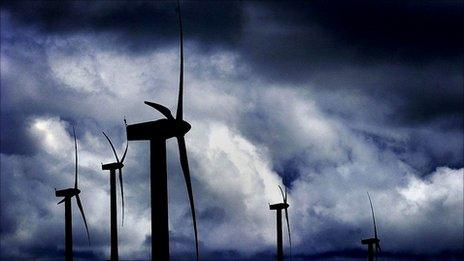Wind expansion divides community
- Published

Until now, opinion in the area was pro-renewable energy
In the peaceful countryside of mid Wales there's a change in the air.
It is a place where green-minded incomers mingle happily with local farmers.
Opinion is broadly pro-environment and pro-renewable energy. Most people have been relaxed about wind turbines sprouting from the flat tops of the Cambrian mountains.
Maybe that is because it is hard to see the turbines from the valleys. The soggy upland plateau doesn't attract walkers, either - most of the best views are on the way up or down. And few roads pass over the tops.
The other key factor is that, until now, the power from the turbines has been gobbled up by the current electric grid, so few new pylons have been needed.
But now the community is suddenly and dramatically divided over plans for a massive expansion including many hundreds of new turbines whose output will overwhelm existing cables.
This will require new overhead cables criss-crossing the landscape, a sub-station covering almost 20 acres and either pylons or underground cables leading the cable connecting the Wylfa nuclear station in Anglesey with the North and the Midlands.
'Angry' response
The wind power expansion feeds the Welsh Government's green ambitions. Its target is 7TWh (TeraWatt/hour) by 2020, necessitating 800MW (megaWatt) more capacity from onshore wind. But many locals in this area of Wales are responding to the plans with anger.
More than 2,000 were said to have attended a recent protest meeting in what is normally an unexcitable region. They are now planning to march on the Welsh assembly, the Senedd. One farmer is pondering a French-style protest involving airborne manure.
A figurehead for the protest is Montgomeryshire MP Glyn Davies. He told the County Times newspaper: "If politicians in Cardiff are going to destroy this part of Wales, I want them to know we will never forgive them."
Another is the weather presenter Sian Lloyd. She has a home in the Severn Valley near Newtown and travelled there for eight hours from London to make her point to us.
She doesn't like wind farms anyway - but she is especially appalled by the prospect of the new infrastructure in the valleys. "This is the rape of the fair country," she said. "It is outrageous that they should consider such a monstrous insult to such a beautiful landscape."
There is an apparent contagion of antipathy among people who have previously supported wind power. Take Philip Pryce, who runs a holiday park at Dolgead Farm near Llanfair Caereinion. Home owners on his site may be treated to a line of pylons on the hilltop under one set of plans.
"I'm not against wind farms," he told me. "I agree with the need to get clean energy and make sure we've got different energy sources. But it's the scale of all this that's taken everyone aback. There's a consultation underway, but we don't feel we've been consulted.
"My fear is that people simply won't want to buy holiday homes here if there are pylons in the view. They come here to escape to the countryside."
Democratic options
The democratic process itself has intensified conflict. The consultation leaves members of the local community potentially campaigning against each other.
I was told by a government contact that the reason ministers have defined the route of HS2 was to avoid upsetting too many different groups of people.
A focus of animosity in Montgomeryshire is the planned 19-acre sub-station. There are two potential sites - one near Abermiwl, the other at Cefn Coch. Members of the community say the area is so far unspoiled by what some of them call an "ugly" industry. But that's not quite accurate.
Abermiwl has a railway track, an old A-road and a new bypass all crammed in by the canal and the young River Severn. Despite that industrial intrusion it still boasts a lovely path down by the river bank and National Grid say they will camouflage the sub-station anyway.
On the map, the Cefn Coch site looked to be located in pristine upland landscape. When I found my way there up a remote mountain road I was amazed to find a gargantuan quarry.
National Grid are hosting travelling exhibitions in the region to explain their options. Their major projects manager, David Mercer, told me: "We understand that people are anxious about the impact on the landscape but we will do our best to minimise that, and we have to remember that getting more renewable energy is a national priority. We have to take the energy from mid-Wales to feed homes across the country."
Certainly the wind farms still command local supporters. Sandy Humphreys works at the Aleppo Merchant pub in the valley below a large wind farm at Carno. From one point in the village you can see a few turbine blades peeping over the top of the hill. "You get used to the turbines and the cables," she told me. "At first people notice them but then you don't see them any more.
"The money from the Community Fund from the wind farms helps local children buy books when they go to university and supports other local organisations. Personally I love walking my dog up among the turbines - you couldn't walk up there before they put the access roads in, it was too boggy. Now I love to be up there. I think this fuss may all die over."
But the rebellious Montgomery residents are invoking the ghost of a similar controversy in 1965 when the village of Capel Celyn near Bala was flooded to supply Liverpool and the Wirral with water for industry.
The insult has remained in the memory, and the wind farm expansion is taking on similar dimensions in the minds of many. It is just one more obstacle in the massive challenge already presented by the government's renewables targets.
- Published12 May 2011
- Published10 May 2011